Back to the Index page
Fungus Foray at Windy Gates, Yearsley 7th November 2009
led by Rhona Sutherland, notes by Rhona Sutherland
Lists of fungi and birds below
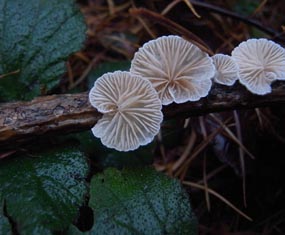 This is an area of damp woodland running east / west along a north facing slope of the Howardian Hills and we were looking at a small area at the top of the slope to compare it with the area down by the lake which we investigated in last year’s foray.
This is an area of damp woodland running east / west along a north facing slope of the Howardian Hills and we were looking at a small area at the top of the slope to compare it with the area down by the lake which we investigated in last year’s foray.
It is an area of mixed Larch, Scots Pine, Western Hemlock, Oak, Beech, Rowan, Birch and Sycamore, and has many different fungi including Crepidotus variabilis (left)..
It was a very dry September so there had been few fungi in the weeks running up to the foray. I was a bit worried there wouldn’t be a lot to show the members on the day but then in the two weeks before Nov 7th it was wet and there were suddenly lots more fungi. I had found one very exciting specimen of a Collared Earth Star – Geastrum triplex – and I was keen to show them this. I had never seen one of these before in this country but they are clearly not as scarce as I thought!
So, imagine my delight when we stepped out of the cars and tripped over at least 4 of the things and then continued to see several more throughout the foray. Other noteworthy species were lots of troupes of the large greyish Clouded Agaric, numerous Orange gilled Gymnopilus penetrans emerging from dead wood and numerous brown or reddish waxy capped, white gilled Collybia butyracea known as Buttercaps in all stages of development. We identified a reasonable number of species but there were still several I could not identify – but that’s what keeps you going out for more!
Twelve members attended, including Jonathan Pomroy who identified the birds below and his young son who was a good fungi forager. Six of us retired for coffee and soup and a stab at identifying those fungi we had collected by making spore prints and studying the literature. For example a noble bay brown dome-capped specimen with a white stipe, streaked at its base and having white gills dropped a beautiful pink spore print which identified it as Pluteus cervinus.
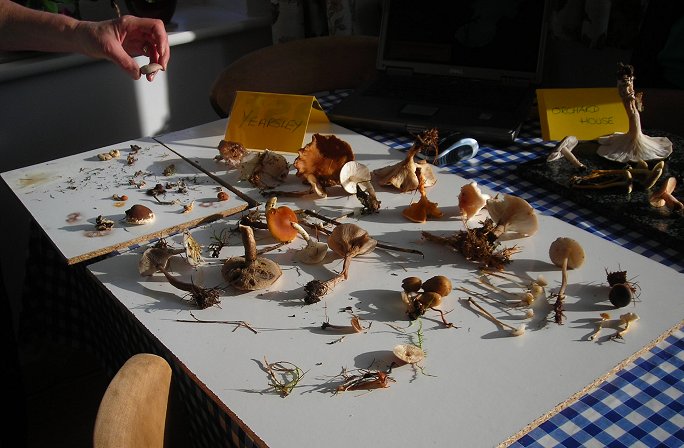
Fungi laid out on the table for identification and to take spore prints
| Latin name | English name |
| Auricularia auricula-judae | Jelly ear |
| Calocera viscosa | |
| Calocera pallidospathulata | |
| Geastrum triplex | Collared Earthstar |
| Lycoperdon excipuliforme | |
| Xylaria hypoxylon | Candle snuff |
| Rhytisma acerinum | Black spots on Acer leaves |
| Crepidotus variabilis | Variable oysterling |
| Trametes versicolor | Turkey tail |
| Phallus impudicus | Stinkhorn |
| Heterobasidion annosum | |
| Piptoporus betulinus | Birch bracket |
| Amanita muscaria | Fly agaric |
| Clitocybe nebularis | Clouded agaric |
| Russula ochroleuca | Ochre brittlegill |
| Armillaria mellea | Honey fungus |
| Lepista nuda | Wood Blewit |
| Paxillus involutus | Brown roll rim |
| Hygrophoropsis aurantiatica | |
| Gymnopilus penetrans | |
| Collybia butyracea | |
| Pluteus cervinus | |
| Hypholoma fasciculare | Sulphur tuft |
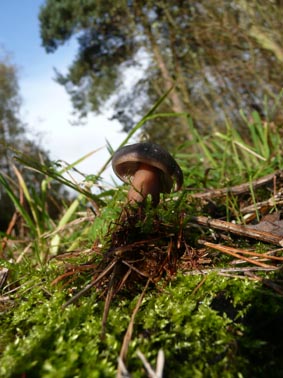
Buttercap Collybia butyracea
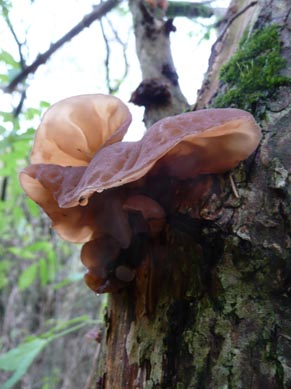
Jew’s ear or Jelly ear Auricularia auricula-judae
|
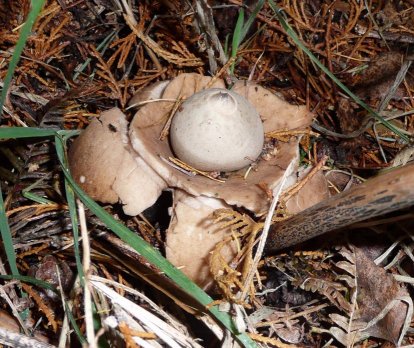
The star of the show: collared earthstar Geastrum triplex
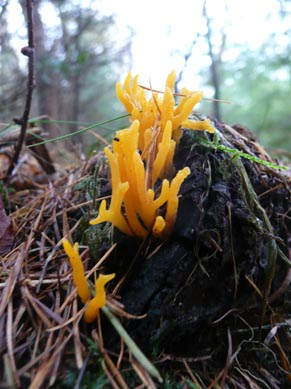
Calocera viscosa
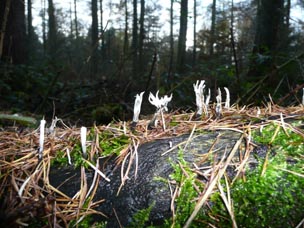
Candle snuff Xylaria hypoxylon
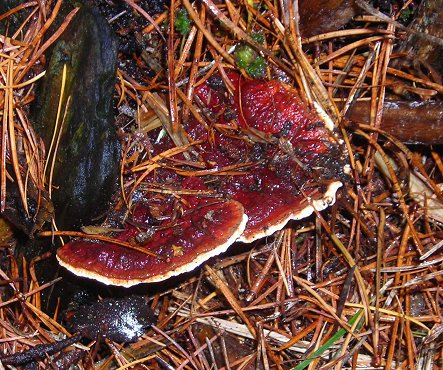
Root-rot Heterobasidion annosum
|
by Jonathan Pomroy:
Birds of particular interest are as follows:
Crossbill 5 flew west then 1 seen briefly in top of larch
Redpoll c.35 feeding on birch and larch
Siskin c.5
Brambling c.10 South West low over trees + 1 female feeding on birch seeds with Redpoll flock
Goldfinch
Chaffinch
Marsh Tit
Long-tailed Tit
Goldcrest (heard several times)
Treecreeper (heard)
Jay
© Ryedale Natural History Society 2009; Photos © Rhona Sutherland, Jonathan Pomroy and Gill Smith 2009
Back to the Index page
 This is an area of damp woodland running east / west along a north facing slope of the Howardian Hills and we were looking at a small area at the top of the slope to compare it with the area down by the lake which we investigated in last year’s foray.
This is an area of damp woodland running east / west along a north facing slope of the Howardian Hills and we were looking at a small area at the top of the slope to compare it with the area down by the lake which we investigated in last year’s foray.





